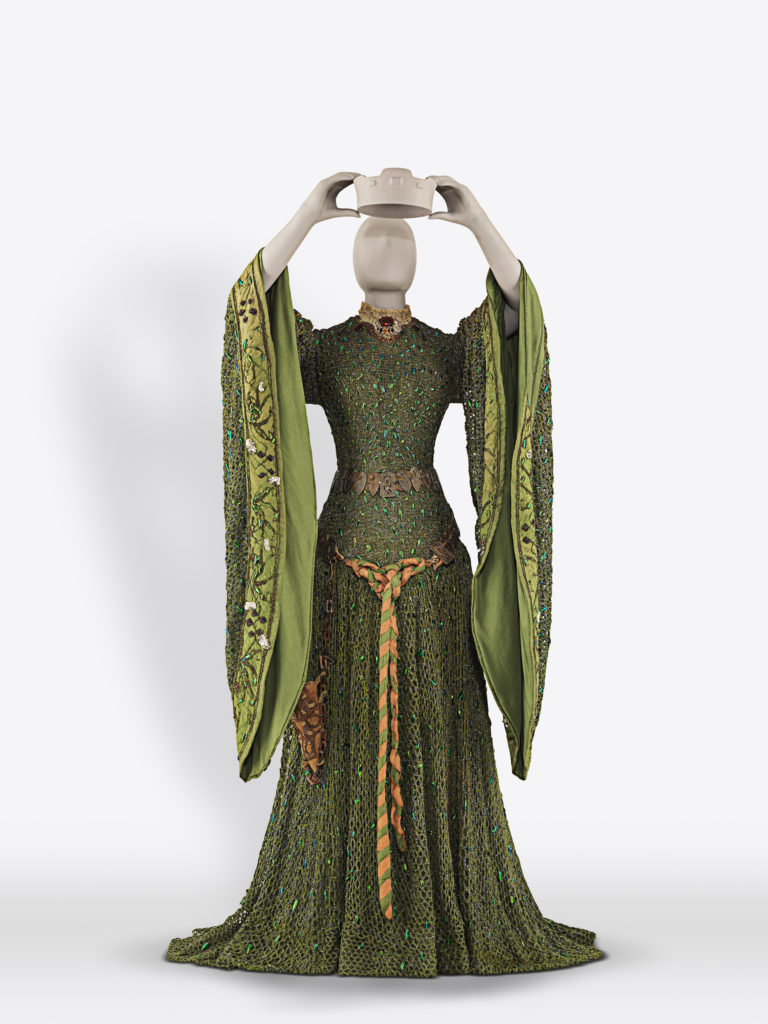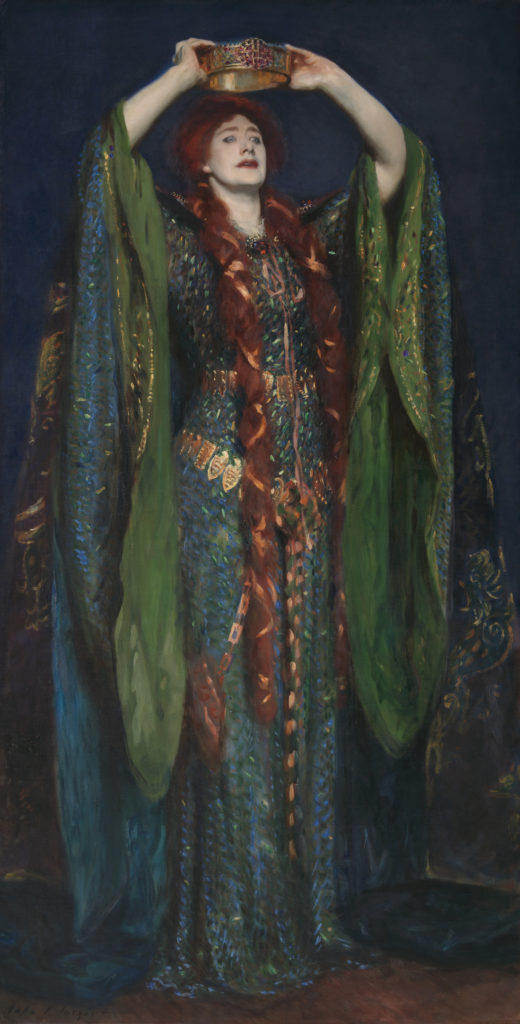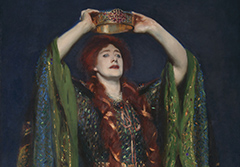
Exhibition:
Fashioned by Sargent
October 8, 2023–January 15, 2024
(Also as Sargent and Fashion, Tate, London, February 22–JULY 2, 2024)
Catalogue:
Fashioned by Sargent
Erica E. Hirshler, with Caroline Corbeau-Parsons, James Finch, and Pamela A. Parmal
Boston: Museum of Fine Arts, 2023.
288 pp.; 150 color ills.
Cloth $65.00
ISBN 9780878468942
“We live, I regret to say, in an age of surfaces,” declares Oscar Wilde’s Lady Bracknell in The Importance of Being Earnest (1895). Wilde’s friend and neighbor, the American expatriate John Singer Sargent, was at that very time nurturing a portraiture practice in London that epitomizes this quality. In her spectacular exhibition, Erica Hirshler, Croll Senior Curator of American Painting at the Museum of Fine Arts, Boston (MFA), has chosen to show Sargent’s work by juxtaposing selected portraits with clothing similar to, and in some cases actually depicted in, those paintings.
There is an irony regarding surfaces in the contrast between Sargent’s portraits and the clothes and accoutrements themselves, many of which are from the MFA’s own collection. Except for the theatrical costumes, these garments are all from the most luxurious purveyors, such as the Parisian House of Worth. Their fabrics, cut, and drape give them clear and distinct surface qualities. Sargent’s renditions, though, are often purposefully imprecise. The rendered clothes are frequently indistinct in their forms, patterns, and folds. The broad yellow ribbons that decorate the dress worn by Edith, Lady Playfair, in her 1884 portrait (MFA) constitute a virtuoso display of painterly attenuation. Sargent painted this work soon after he moved to London from Paris, where he had studied with Carolus-Duran and had begun his portraiture career. Nearly twenty years later, in a 1903 portrait (MFA), Mrs. Fiske Warren wears a pink dress so ill-defined as to be incomprehensible as a garment, while her daughter Rachel, snuggled beside her, is draped in what looks like a rumpled pink sheet.
These bravura displays of paint application evoke, by turns, Diego Velázquez, Thomas Gainsborough, and, in the case of richly varied blacks, Frans Hals. Sargent’s contemporaries admired his skills because they conformed to the dignified conventions of the Old Masters. Anthony van Dyck is an obvious prototype. The affinity with Van Dyck extends to Sargent’s treatment of hands, simultaneously clawlike and flaccid. Yet the hands are as nothing. Hirshler is right to claim that for Sargent the clothes made the sitter. The label beside the 1894 portrait of Wilde’s associate, the costume designer and illustrator W. Graham Robertson (Tate, London), states that the long black coat Sargent obliged the sitter to wear was essential. Sargent reportedly told Robertson: “The coat is the picture. You must wear it.” And wear it he did.
Sargent often clothed his sitters. In the case of the 1922 portrait of Sybil, Countess of Rocksavage (private collection), Sargent went so far as to commission her dress from Jean-Philippe Worth. Installed beside the portrait, the garment is a fancy-dress fantasy based on sixteenth-century portraits of Anna of Austria, queen of Spain. Not present, though, is the enormous rope of pearls that Lady Rocksavage wears in the portrait. She had reportedly received it from her French mother, Lady Sassoon (born Baroness Aline Caroline de Rothschild, whose 1907 portrait in a private collection is in the exhibition). Also not present is the double-headed eagle brooch Lady Rocksavage wears, provocatively evoking the Habsburg dynasty. It belonged to her baronet brother, Sir Philip Sassoon, whose 1923 portrait by Sargent (Tate, London) also hangs in the exhibition. Such a costume and such baubles clearly show that Sargent pandered to his sitters’—in these cases, his friends’—pretentions.
Many of Sargent’s British sitters, like Sir Philip and his sister, Lady Rocksavage, were aspirants to the highest echelons of society. However, like Sargent himself, who never relinquished his American citizenship and so remained a precariously placed outsider in British society, these predominantly Jewish men and women could never break a scarcely perceptible glass ceiling despite their wealth. Sybil Sassoon may have married George Cholmondeley, Earl of Rocksavage, in 1912, and been styled Marchioness of Cholmondeley after her husband succeeded to the marquisate in 1923, but that union was a calculated move to restore the depleted Cholmondeley fortunes with Sassoon and Rothschild money. It was a maneuver like that by the ninth Duke of Marlborough, who in 1895 married Consuelo Vanderbilt, daughter of the immensely wealthy railroad heir, William Vanderbilt. Being an American, she was only acceptable to an aristocratic British family owing to her immense dowry. In the minds of many frequently xenophobic British aristocrats, foreign origin or ancestry carried an indelible taint, however faint it might eventually become. Anthony Trollope explored this matter in his caustically comic novel Is He Popenjoy? (1878).
Sargent, and other outsiders who longed to be accepted—and, in certain respects, came to be—were drawn to each other as portraitist and sitters. They so longed to belong that they conformed to the conventions of the day. Sargent learned his lesson in this respect early in his career in Paris where similar norms and prejudices reigned. Sargent and his sitter Virginie Amélie Avegno Gautreau, the American wife of a French banker, flouted social conventions in his 1884 Portrait of Madame X (Metropolitan Museum of Art, New York). He depicted the Louisianan, already notorious for her extramarital liaisons, in a scandalously skimpy dress. Sargent’s error was the painterly equivalent of the fictional remark by Wilde’s Algernon Moncrieff, “I don’t care twopence about social possibilities.” His aunt, Lady Bracknell, immediately admonishes him: “Never speak disrespectfully of Society, Algernon. Only people who can’t get into it do that.” The resulting dearth of portrait commissions following critical outrage when Portrait of Madame X was shown at the Paris Salon encouraged Sargent to leave Paris for London to relaunch his portrait career. He learned his lesson and never repeated his mistake.
Sargent courted sitters from another swathe of outsiders: those who belonged to what might now be termed the queer community of which he was himself a member. Such men had to be discreet since same-sex physical liaisons were illegal. Wilde discovered this to his cost when in 1895 he was found guilty of gross indecency and sentenced to two years of hard labor. Sargent was guarded about his gay sitters’ proclivities, masking them with a façade of icy conformity, as in the case of his 1923 portrait of Sir Philip Sassoon. British society had long been far more tolerant of same-sex love between women and the use by some of male attire. The “Ladies of Llangollen,” a lesbian couple whose late eighteenth-century model-cottage home in Wales made them famous, had even received a civil list pension (a modest royal allowance). In 1881, Sargent had no difficulty in painting his exact contemporary (they were both born in 1856), fellow expatriate (though of British parents), and friend from childhood Violet Paget in her masculine identity as Vernon Lee, the name she adopted both as an author and in her personal life (Tate, London). The figure in this sketchlike, bust-length portrait sports the markers of a young man: short hair, white Gladstone collar, and black jacket. Such a refusal to conform to contemporary conventions of femininity resonated as eccentric though not necessarily as perverse.
Performing artists also occupied equivocal social positions, and Sargent associated with several. Two remarkable survivals exemplify his enthusiasm. One is the spangled, bell-shaped dress, “bolero” jacket, and beaded shawl trimmed with silver-gilt thread (private collection) worn by Carmen Dauset Moreno, known as La Carmencita. She was a celebrated Spanish dancer billed as “the pearl of Seville” whom a captivated Sargent painted in New York in 1890 (Musée d’Orsay, Paris). Sargent kept the dress and later lent it to Sybil Sassoon (the aforementioned eventual Marchioness of Cholmondeley) for a party, so that a costume ironically connected an outsider dancer to an outsider social aspirant. The other instance of a performer and her dress is yet more remarkable: the “beetle-wing dress and cloak” designed by Alice Laura Comyns-Carr in 1888 for the most prominent London actress of the day, Ellen Terry. Terry wore it in the role of Lady Macbeth (National Trust Collections, Smallhythe Place: The Ellen Terry Collection). Sargent’s striking full-length portrait of Terry as Lady Macbeth (Tate, London) depicts her holding a golden coronet above her head, showing off her knee-length hennaed tresses, dress, and cloak to maximum advantage. It hangs in a striking gilded Celtic-patterned frame beside the dress itself. Together they constitute the most remarkable trio of inventions in the exhibition.

Dating from the late Victorian era, when Britain’s empire was at its height (the empire on which the sun never set—or rose, depending on one’s point of view), the items associated with Terry evoke not only thespian social equivocacy but also imperial exploitation, a theme that resonates throughout the exhibition though with only occasional comment. The thousand or so “beetle wings” on the dress worn by Terry are the green and blue iridescent elytra or wing cases of beetles of the genus Sternocera, native to the Naga areas of northeast India and northwest Myanmar (Burma). The Indigenous inhabitants of the Naga Hills gathered such beetles at the end of their natural life span of three to four weeks and adapted them as constituents of a variety of symbolic personal accoutrements. From the 1880s, merchants and artisans from Bengal got hold of elytra after the British had established a tenuous colonial rule in what they called the Naga Hills District (established in 1881) and used them as decorative elements in items such as baskets. Sargent’s Ellen Terry as Lady Macbeth and her dress both exude a calculatedly sinister exoticism that casually exploits the imperial appropriation of a natural resource with strong cultural connotations for the Native peoples of the contemporary Indian state of Nagaland and their neighbors in northwest Myanmar.

British imperialism makes overt as well as veiled appearances in individual portraits. In Sargent’s 1898 three-quarter-length portrait of Colonel Ian Hamilton (Tate, London) the sitter wears a scarlet full-dress uniform sporting gold frogging, decorations, and medals. This gorgeousness is somewhat toned down by his open dark-blue army greatcoat. Yet even in near profile, he projects an air of command. He might have been addressed by Wilde’s Lady Bracknell: “There are distinct social possibilities in your profile. The two weak points in our age are its want of principle and its want of profile. . . . Style largely depends on the way the chin is worn.” Colonel Hamilton, the victor of the storming of the Dargai Heights on the Indian Northwest Frontier in 1897, certainly wears his chin assertively if not aggressively.
In 1903, Sargent was commissioned to paint an official portrait of Sir Frank Swettenham, who, since 1871, had served in the civil service of the Straits Settlements (in present day Malaysia and Singapore). Two years earlier, he had been appointed governor and commander in chief of the Straits Settlements. Sargent painted a second version for Swettenham himself the following year (National Portrait Gallery, London). The governor wears a brilliant white tropical uniform with the jeweled star of a knight commander of the order of Saint Michael and Saint George at his breast. Other accoutrements, including a cascading length of red and gold Malay brocade fabric, derive from Sargent’s studio but convey Swettenham’s power to rule in this strategically vital colony.
Sargent’s portrait images of male command, power, and position were not limited to the British imperial sphere but extended to the metropole. The portrait in the exhibition that may strike many contemporary viewers as the most pretentious is a life-size, full-length likeness of an unequivocal member of the highest British social elite (despite his Irish origin and title), Charles Vane-Tempest-Stewart, sixth Marquess of Londonderry (Museum of Fine Arts, Boston). Londonderry, accompanied by a page who bears his coronet, wears the splendid outfit he had donned for the coronation of King Edward VII in 1902. He advances his left leg to show off the insignia of England’s most prestigious chivalric order, the Garter. Most conspicuous, though, is the “great sword of state,” which is carried vertically, as it is in the portrait, before the monarch on state occasions, including coronations. The British elite regard the assignment to bear the sword of state as a singular honor, and it has long been conferred on a prominent military commander or politician. By the time of the coronation, Londonderry had served successively as lord-lieutenant of Ireland and postmaster general between 1900 and 1902 in the Marquess of Salisbury’s cabinet. Whereas participation in an imperial pageant, such as the coronation of Edward VII, might impress susceptible onlookers as it happened, a life-size frozen image derived from a ritual in motion can come across as no more than bombastic. By contrast, in 1917, Sargent presented Londonderry’s older American contemporary, John D. Rockefeller—a man of far greater consequence than the Irish marquess—in an exaggeratedly modest manner (Kykuit, Sleepy Hollow, NY, National Trust for Historic Preservation). Wearing an informal dark serge coat with plain pale vest and pants, the obscenely wealthy Standard Oil magnate is seated in a simple Windsor chair. This is not merely a question of republican modesty contrasting with monarchist pompousness. Rockefeller simply does not have to show off. It is enough that by its very existence this sizeable though undemonstrative portrait proclaims that Rockefeller had persuaded the imperious Sargent to do his bidding since, by 1917, Sargent had largely given up painting portraits of anyone other than his friends.
What do we learn from Fashioned by Sargent? Is it that portraiture is invariably a matter of calculation, such as a choice of garb when one has the privilege of being able to select the latest Worth dress or plush silk top hat? How might Sargent have treated more modest folks whose choices were more restricted? Viewers get some idea in the last room of the exhibition where, under the title “Outside Fashion,” we see informal plein air scenes of mostly young people exhibiting what the Daily Telegraph of London termed “a magnificent disregard of the conventional proprieties” when describing Group with Parasols (A Siesta) of about 1904–5 (Middleton Family Collection) He shows two young women and two young men—known friends and lovers—lying together on a verdant Alpine bank. In Cashmere of about 1908 (private collection), seven young female figures—all modeled by Sargent’s niece Reine Ormond—process from left to right, each variously draped in the same pale Kashmir shawl edged with broad paisley trim. Sargent gave this shawl—or one so similar as to be indistinguishable (private collection)—to Sybil Sassoon, and it lies artfully rumpled in a case before the painting.
Pairing portraits with actual clothing and accessories worn by sitters is long-established museum practice. Such an exhibition built around J.-A.-D. Ingres’s Portrait of Madame Moitessier (1844–56) in the National Gallery, London, took place some fifty years ago. The shock of the real—a dress, a shawl—can be salutary, reminding the viewer that just as the hat, fan, or jewel in a portrait has a tangible prototype, so the figure depicted also existed as an actual human presence. As Ralph Waldo Emerson asserts in his essay “Art,” the skill of the artist—Sargent, in this instance—is to draw attention to the peculiarities of a single object of attention, “to make that for the time the deputy of the world. . . . For the time, it is the only thing worth naming.” The juxtaposition of portraits and some of the items they depict enhances this conception since it brings together both a fragment of the world and the likeness that is for a time its deputy. This is a lesson not so much for the intellect as for the emotions but is none the worse for it.
Ivan Gaskell is Professor of Cultural History and Museum Studies at Bard Graduate Center, New York City.

